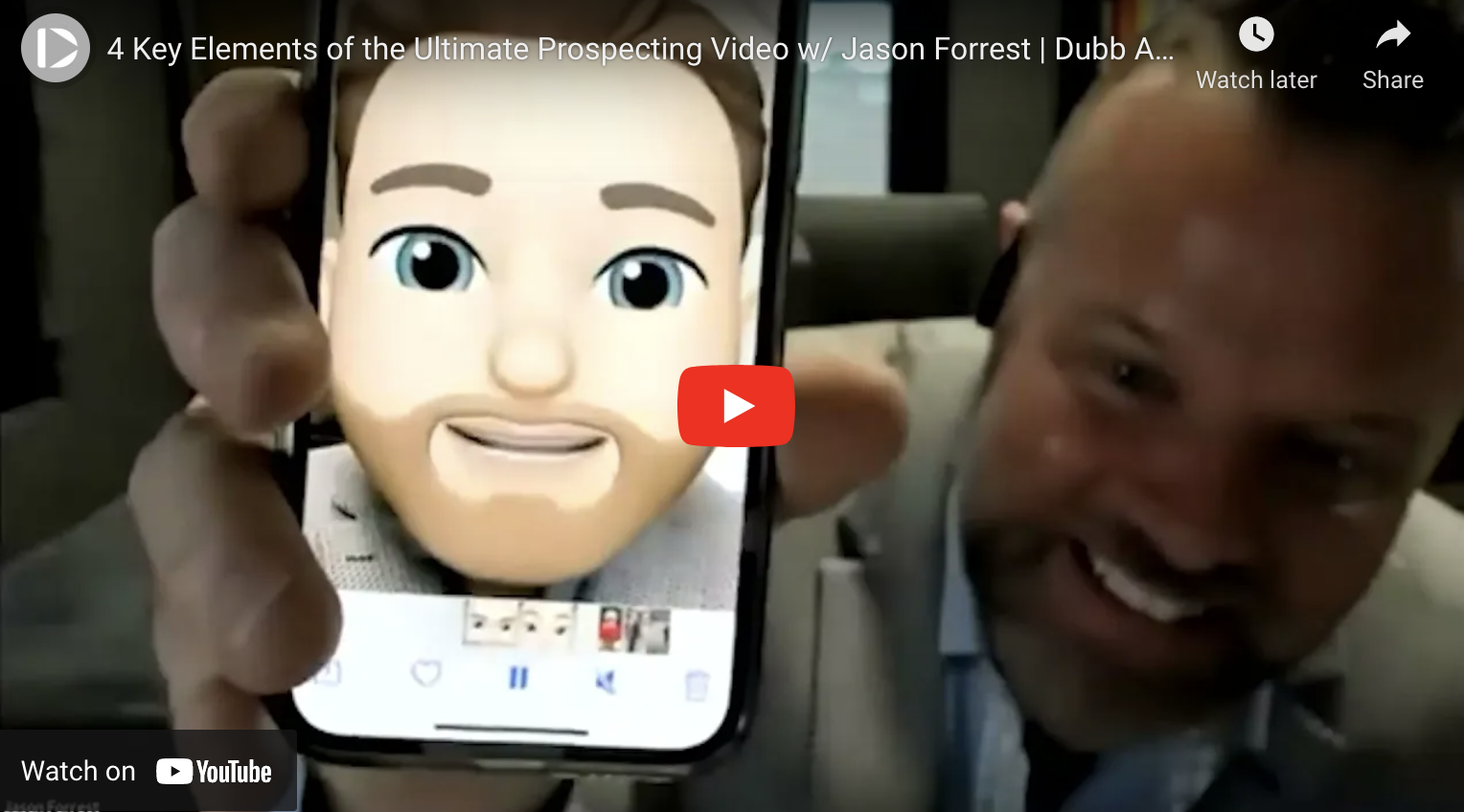Have you been looking for some of the key elements to making the ultimate sales prospecting video? Or have you been searching for a way to consistently create awesome videos that lead to sales?
If so, you are at the right place. Whether you work for a small or large company, you have the power to create awesome prospecting videos that help you reach your sales goals. Better yet, there are four key elements that can help you get from point A to point B.
To better understand those elements, we recently spoke with Jason Forrest. Jason is the founder of Forrest Performance Group (FPG), which offers sales recruiting, sales training, and leadership training to clients. Jason and his team transform their clients into ultimate sales warriors. By doing this, FPG is the fastest-growing sales training, sales management training, and sales headhunting and recruiting company in the United States.
Simply put, Jason is a practitioner in his craft. He and his colleagues take pride in eating their own cooking. Essentially, Jason and his team implement everything that they teach their clients. Jason personally field tests his tactics and strategies to get the kinks out of them. To do this, he uses the philosophy of hypothesize, test, and pivot. Essentially, he hypothesizes what he thinks is going to work. He then tests it and obtains data from those tests. Finally, he and his team make any necessary adjustments. Once he puts his stamp of approval on a certain tactic or strategy, his team will then implement them in training videos for FPG’s clients.
With this background in mind, Jason is a great person to discuss the ultimate sales prospecting video. Whether you are struggling to meet your sales goals or simply want to create more effective prospecting videos, I encourage you to implement Jason’s strategies and tactics below.
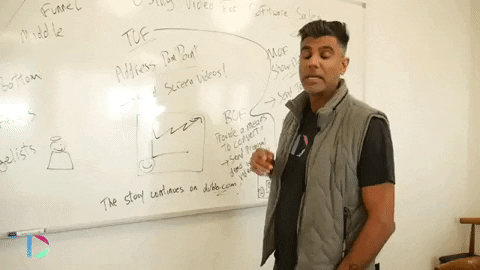
The Power of Neuro Linguistic Programming (NLP)
Jason and his team are huge proponents of neuro linguistic programming. To break it down, “neuro” stands for the brain. “Linguistic” stands for our speech patterns. As Jason says, what has been proven by science and psychology is that the way we speak to ourselves and others is a window into how we think. From there, how we think drives how we feel. How we feel drives our motivations, our motivations drive our behaviors, and our behaviors drive our results.
Jason encourages us to think about that further. If the way we speak is a window into how we think, and how we think ends up driving our behaviors and results, then it is possible to program how others think through our words. In other words, we can use our words to persuade how others think about us, therefore changing their motivations. This process transforms their thinking into “want to” motivations rather than “have to” motivations. Your prospects can feel like they want to get on the phone to hear your pitch, rather than feeling they have to get on the phone and listen to your message.
Ultimately, Jason argues that NLP is that powerful. It can play a huge part in helping you get much closer to your business goals. Even if you haven’t heard of NLP before reading this article, you are already familiar with it. We encounter it every day. For instance, every time that you have a negative thought in your life, that thought has a direct effect on your feelings. A negative emotion then affects your motivation, behavior, and results. A perfect example involves the early days of Covid-19. With so much uncertainty in the world, it was all too easy to have negative thoughts on both a macro and micro level. Those thoughts, therefore, affected our feelings and actions during those challenging times.
The good news? NLP can be used in a more productive and positive light. Positive thoughts, whether they were about a new business opportunity or even a new crush, directly impacted your motivations, behaviors, and results. Using NLP this way, we can achieve our business goals, improve our lives, and create the ultimate sales prospecting video.
Four Key Elements to Making the Ultimate Sales Prospecting Video
With that basic understanding of NLP in mind, Jason moved on to discuss a great strategy that you can leverage when creating and using Dubb videos. Jason is a Dubb power user and relies on Dubb to get potential customers to notice FPG. Specifically, he uses four steps to make his videos stand out.
Those four steps are: (1) disrupt the pattern, (2) make it personal, (3) teach them something, and (4) a call to action. Jason shortens it by calling it “DPTC.” By incorporating these elements into your sales videos, you will find that your sales videos will get you much closer to your sales goals. Whether you are creating sales videos for the first time or want to create better sales videos, you can incorporate Jason’s framework within your sales process.
Disrupting the Pattern
So from an NLP perspective, why would we want to disrupt our prospects’ patterns? As Jason says, think about all of the noise that is out there. Most likely, many of your prospects are getting blanket emails. Those emails are extremely generic and are most likely instantly deleted by your prospects.
Because of this, just picture what could happen if you send a video to those prospects. By doing this, you have disrupted a pattern in your prospects’ lives. When your prospects see that you have created and sent a customized video to them, they are much more likely to open the video and actually watch it. The simple fact that you are sending a video (and including the word “video” in your subject line) drastically moves the odds in your favor. Your message can be a valuable signal in a world that is full of noise.
So what happens if video becomes the common way to communicate? The same principle applies here. You need to disrupt the pattern. For instance, you can do this in the video itself. As Jason described, there are many possibilities here. In one of Jason’s Dubb videos, he presents a goofy image. When Covid-19 hit the world, Jason’s wife took a picture of him joking around in an elevator. He was wearing his mask over his eyes instead of over his nose and mouth. That image was part of a one minute 22 second video that he sent as part of a campaign. The campaign had a very high conversion rate—partly because Jason was able to disrupt the pattern of recording a “generic” video by including this jarring image at the beginning of his video. From there, he was able to pitch his firm and explain how his company could provide value to viewers. He then concludes the video by offering a call to action. Specifically, he invites viewers to contact him personally.
Below the video, he even provides viewers with a link to his calendar. After watching the video, the viewer can easily schedule a conversation with Jason, thereby drastically increasing the chances of him making a sale. Using Dubb, you can also easily add follow up videos through Dubb’s playlist feature. It is a great way to keep your viewers engaged, provide even more value, and further increase your chances of hitting your sales goals.
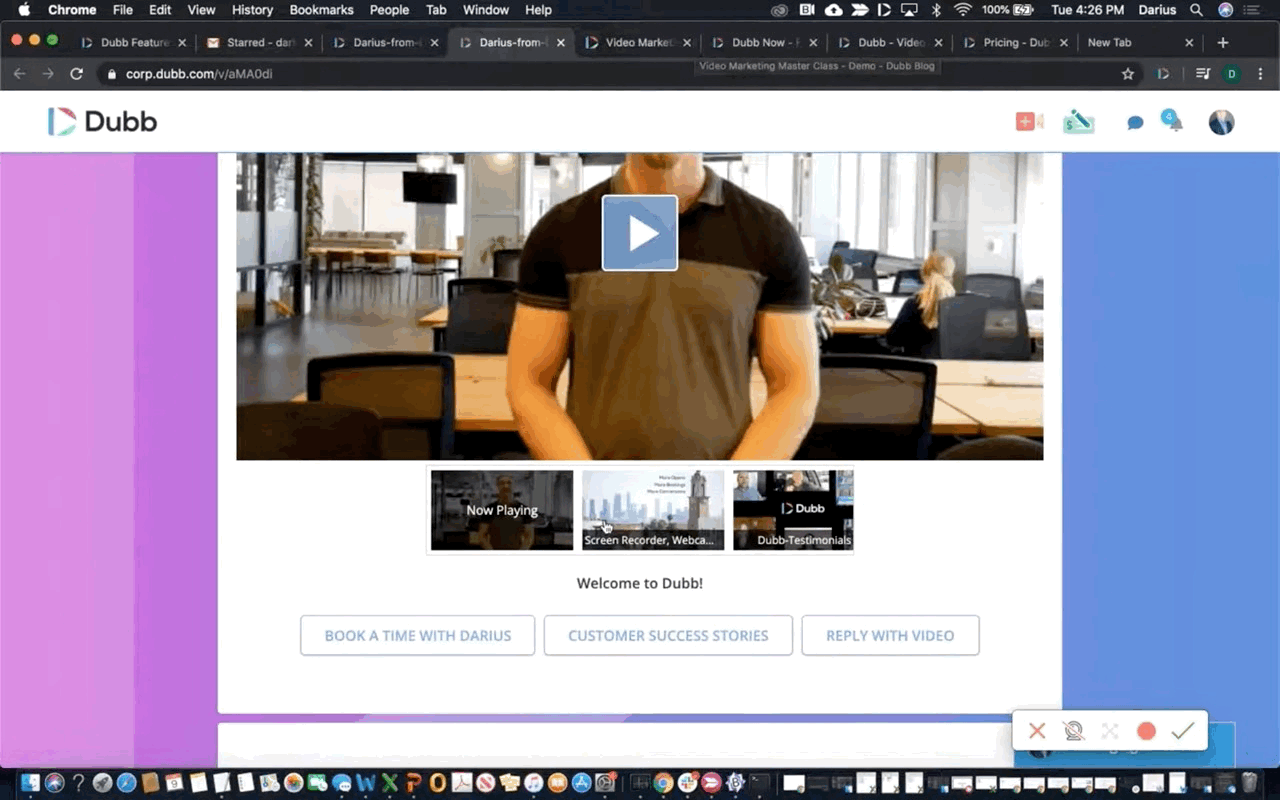
Using a Dubb action page, you can even change up the features below your videos. For instance, Jason likes to include testimonial videos below the featured video. Those testimonial videos provide extremely valuable social proof and make it much easier for viewers to trust you and your company. They can be powerful assets that you can use with some (or all) of your Dubb action pages.
So what can we learn from this case study? First, Jason disrupted the pattern by including a strange image of himself (his mask over his eyes). He also disrupted the pattern by stating, “I may not know how to wear a mask, but I do know how to do this.” He then teaches viewers something new that they hadn’t thought of before. Finally, the call to action is a great way to invite your viewers to learn more (and perhaps get in touch with you or a colleague).
There are plenty of other ways to disrupt the pattern. For instance, Jason created his own memoji of himself. It’s an animated version of his face that he created using Apple Clips. From there, he added his memoji to Dubb so that he could send out his memoji in some of his sales videos. The entire video was a memoji, making it something that his viewers tended not to frequently see in their inboxes.
Jason also disrupted the pattern during the holiday season. One of his friends owns hiresanta.com and he paid $100 for one of the Santas to read a specific script. He then took that video and uploaded it to Dubb. From there, Jason created a personalized video for each of his viewers after the Santa clip. That video played off of the Santa clip and included Jason pitching his company and showing how his company could get that viewer closer to their sales goals.
Finally, Jason offered an example that included a member of his family. Once a week, Jason and his son go boxing at the local boxing club. Jason had his son take a video of him boxing. From there, he followed the playbook above. He sent the video of him boxing and then added a personal sound bite at the end of the video. That was another Dubb campaign that he used to generate business.
These are all examples that Jason has used to disrupt the pattern. All you need to do is change up your outreach.
Disrupting the Pattern in Your Industry
At this point, Jason says you may be thinking that this advice may not apply to you. You may work in an industry or for a company that is more “buttoned up” than others. Consequently, it may seem like you can’t create an overly funny or corny video and send it to a prospect.
Jason tends to think otherwise. He mentioned that Komatsu, the large commercial machine manufacturer, worked with his team to create selfie videos. They then sent those selfie videos to their key prospects. Out of seven national accounts, all but one got an immediate follow up. The team was ultimately able to close more than $1.6 million in sales by simply sending selfie videos.
Why does it work? Again, it comes down to disrupting the pattern. Selfie videos are unique and are unlike many messages that your prospects will receive in their inboxes. Better yet, you don’t need to be a professional speaker to do it. I believe that in today’s day and age, the idea of “professional” is vastly different than it was decades ago. A professional video is one that is sincere, brief, and that adds value to your viewers’ lives. You don’t need to be all buttoned up or hire actors to create a professional-looking sales video. This is an extremely empowering fact that you can leverage in your sector or industry.
Make It Personal
The second part of making the ultimate sales prospecting video is making that video personal. I alluded to this above, but it’s important to go into some more detail here.
As Jason says, Dubb has many different types of tools that can help you customize your sales videos. For example, you can easily add the viewer’s name to your video. This is an extremely easy way to personalize your videos. It may not seem like much on the surface, but it can actually go a long way. By simply including your viewer’s name on your sales video, you can, once again, disrupt the pattern. You show your viewer that you took time out of your busy schedule to focus solely on them. Combined with the other key elements, this basic type of personalization can help you get closer to a sale. Using Dubb, it is extremely easy to add personalization text to your videos. It should be a regular part of making your sales videos.
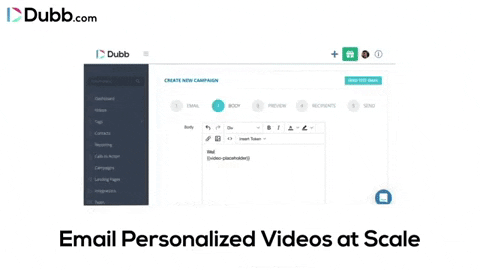
Jason mentioned some other ways that you can make your sales videos personal. Sometimes in his sales videos, Jason will have a laptop. That laptop will have the viewer’s website displayed. It’s another way to add a personal touch to his sales videos and show the viewer that he or she isn’t just another sales prospect. Jason has also created Dubb videos where he has shared his screen and displayed the viewer’s LinkedIn profile. Therefore, when Jason sends the prospect a Dubb video, the picture is their LinkedIn profile. As Jason says, who isn’t going to click on that type of video? In that video, Jason speaks about things that he noticed in their profile, and then he ties them to his business. Ultimately, what Jason is doing here is building rapport with what he noticed in that LinkedIn profile.
These are just some of the ways that you can make your videos personal. I’m sure that you can come up with even more creative ways to do so. At the end of the day, making your videos personal is an essential way to build closer relationships with your viewers and create the ultimate sales prospecting video.
Teach Them Something
Now, let’s talk about teaching your viewers and prospects. This concept of education is so important in the ultimate sales prospecting video. At Dubb, we always encourage our community members to prioritize education in their video content. Even though we all want to reach our sales quotas or sales goals, we can get much closer to them by leading with value. While it may seem “slower” than leading with a hard pitch, you’ll find that emphasizing education and value is a more efficient way of converting more prospects into paying customers.
When Jason thinks about teaching and education, he tries to prioritize two or three things for his viewers. Jason cited evidence that customers are not looking for a faux friend. Instead, they are looking for an advisor. They are looking for someone that they can mutually respect and someone that can take them to a place that they couldn’t on their own.
Ultimately, all humans strive to move away from pain and towards life improvement. One of the beliefs that Jason and his team have is that, as a salesperson, your job is to earn your prospects’ respect. So how do you earn people’s respect? You teach them something that they haven’t learned before.
Naturally, this forces you to ask the question of what sorts of things you can teach your prospects. One tip that Jason suggests is getting Google Alerts on trends in your sector or industry. Simply getting alerts on economic data can also be valuable.
In Jason’s case, he created a Dubb campaign where he shared his screen. On his screen, he had this cool graphic that showed the economic booms and busts over the past 100 years. He then walked the prospect through the graphic (this video was created and sent in 2020). Essentially, Jason argued that after every bust is a boom, so how is the prospect preparing for the inevitable boom? Jason then argued there were two ways. First, ensure that you have enough salespeople on your team. Second, make sure your salespeople have the proper training to take advantage of the boom cycle. Then, he argued that if any of those things are important to the prospect, he or she could book a call directly on Jason’s calendar. By using a third-party graphic and walking his prospects through that graphic, Jason was able to add value and teach his prospects something new.
Leading with value can be a true game-changer for your sales efforts. While it may take some time to discover what your audience wants to learn, investing the time can lead to massive dividends down the road.
Embrace the VETO Selling Message
As part of the “teach them something” prong to creating the ultimate sales prospecting video, Jason mentioned a key framework that he teaches his clients. It is called the “VETO Selling Message.” The idea is that you want to veto the customer’s current perspective on what they think about you. Essentially, you want to carve out a unique niche in your customer’s mind so that they see you differently.
VETO is an acronym that stands for “Vision, Example, Teach, Own.” Jason thinks of VETO as a subset of what you are going to teach your prospects and customers.
Going through the acronym, your vision is basically what is unique about you. Ask yourself these questions:
- “The reason people choose us is ____.”
- “When our founder decided to create our company, the goal was to disrupt ____.”
- “The vision of our founder was to be the best at ____.”
- “The problem that our founder saw in the marketplace was ____.”
Ask yourself these questions to better understand your vision. This will e an important component when you go to educate your audience.
Once again, the “E” in VETO stands for example. You can also use “evidence” interchangeably here. In this prong of VETO, you can share a story of how you helped a certain business go from A to B. You can further discuss the three (or however many) ways that you helped that business get from A to B, thereby providing valuable context that the prospect can relate to. Providing an example is a great way to help your prospect relate to your company.
The “T” in VETO stands for teach. This is providing more context to the example that you provided above. You don’t necessarily need to have a hard sell at this point. What you are trying to do here is improve the prospect’s life—even if you don’t necessarily make a sale. Lead with education and good things will follow.
Finally, the “O” stands for own. Here, you are building on the example and teach portions of VETO. You are showing what this would look like if the prospect decided to work with you. You are providing more context should the prospect sign on the dotted line. You put the example in their world and help them visualize success.
The VETO Selling Message is yet another way that you can disrupt the prospect’s paradigm of how they see you. So how do you create a great VETO? Jason has some suggestions here.
First, he asks you to think of your biggest competitor. Then ask yourself: what makes you unique in comparison to your biggest competitor? By sufficiently answering this question, you can challenge the perspective of your viewers and listeners. Secondly, ask yourself about a situation where you helped someone. What were the two, three, four, five, or more ways that you did that? And then ask yourself what that assistance would look like in your prospect’s world.
As Jason says, the VETO is everything to him. When thinking about how to teach someone about your product or service, you should definitely incorporate this VETO framework.
Use a Call to Action
The final key element of the ultimate sales prospecting video is including a call to action. As you probably know, a call to action is a way to lead a prospect down your sales funnel. In other words, it is a device that you can use to get any type of prospect much closer to the sales finish line.
Using Dubb, you can take advantage of a whole host of calls to action. Some of those many calls to action include the following:
- Reply with video: This is a fantastic way to have your viewers engage with your videos. After watching your video, your viewers can click one button and record a video of their own. It is a more convenient way to respond to a video versus typing out a lengthy email. Moreover, you can use the reply with video feature to gather customer testimonials. Because customer testimonials are such powerful signals of social proof, you shouldn’t hesitate to take advantage of this call to action.
- Direct calendar booking: As I’ve mentioned above, one of your calls to action can be the ability to directly book appointments on your calendar. This is a great tool at the top of your sales funnel. After getting significant value from one of your sales videos, you can easily get your viewer on the phone to further speak about your products, services, and company.
- Chat via Facebook Messenger: Sometimes, your viewers may not want to communicate over the phone or email. Because of this, you can include a call to action that lets your viewer communicate with you via Facebook Messenger.
- Make a purchase: This is one of the most exciting calls to action. Below one of your videos, you can include a button to purchase one of your products or services. While this is likely to be more effective at the bottom of your sales funnel, you can include it wherever you’d like.
Whichever calls to action that you prefer, make sure that you include at least one of them below each of your videos. Without a call to action, you will find it much harder to make sales. On the flip side, by including a call to action, you actively move the relationship forward. You give your viewer a chance to learn more about your company and to get more value from you. In the end, it’s a win-win and helps you create the ultimate sales prospecting video.
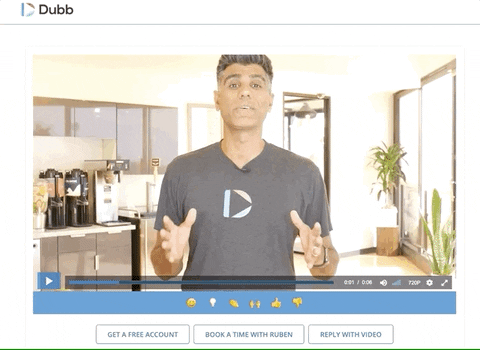
Additional Points to Keep in Mind
These four key elements are essential to making the ultimate sales prospecting video. By focusing on them in all of your sales videos, you will be in a much better place to create stellar prospecting videos for your prospects.
To wrap up the conversation, Jason mentioned a few additional points to keep in mind.
First, try to be provocatively respectful. When you are creating your ultimate sales prospecting videos, you don’t want to call out your competitors by name. At the same time, you need to write provocative scripts that are ‘edgier” compared to those competitors. Truthfully, there is more art to science here. You may need to edge the line on some of your videos. This is so you can actually determine where the line is. With that said, don’t hesitate to embrace the edge in your videos. It is yet another way to disrupt the pattern and get your audience’s attention.
Along with being proactively respectful, see yourself as an advocate. Jason thinks of an advocate as a modern-day protester. Regardless of your political position, it’s clear that the person who protests has massive conviction. They have a belief system that says what they believe matters. They need to tell the entire world about their belief and they go out into the world and do it.
To be a phenomenal prospector, you need to be an advocate. You need to adopt this mentality of having significant conviction in your product, service, or company. After all, if you don’t have this conviction, why would a prospect purchase from you? He or she would most likely choose to work with one of your competitors. No matter what it is that you are selling, make sure that you are taking an “advocate approach” to your sales process.
And if you aren’t an advocate? Jason argues that you need to figure out what is holding you back from being an advocate. You may need to look at the company you’re working with, do some research, and determine how you can sell yourself first on what you’re offering. In other words, you need to ask yourself: “Why would I buy this? Why is this better than the competition? Why is the competition doing it wrong and why are we doing it right?” You need to answer these questions and then create a VETO around them.
Finally, understand how you and your company fit into your prospects’ world. To put it another way, make sure you recognize what is unique, special, and different about you. Why should your prospects care about what you have to say? All of our prospects are busy. They don’t have all the time in the world to study your company and learn about how you fit in your industry. You need to articulate that to them, whether you are meeting those prospects for the first time or are convincing a current customer to purchase even more goods or services from you.
If you have seen the film Walk the Line, you probably know what Jason is talking about. In that film, Joaquin Phoenix (who plays Johnny Cash) was going into a recording studio. The man in the recording studio told Johnny Cash that he was trying to sing the same old song that everyone else sings. He essentially asked Cash, “Do you have anything different, or is that all you have?” He then asks, “Can you go down deep into your soul to give me something unique and special?” All of the sudden, Cash gave that individual an amazing song.
Keep this story in mind. When you are creating sales videos or simply pitching a prospect in-person, be clear on what value you are providing to the world. It may not be obvious right now, so don’t hesitate to invest some time into this task.
Create Your Ultimate Prospecting Videos
Prospecting can be difficult. In effect, you are trying to convince an individual to take a chance on your company. Especially if you are a founder or work for a small, young company, that job can be even more difficult.
This is why it is so important to create stellar prospecting videos. Ultimately, the ultimate sales prospecting video contains the four elements mentioned above. In fact, Jason tends to incorporate these four elements into a general outline for each of his videos. By disrupting the pattern, making it personal, embracing education, and leveraging a call to action, Jason makes it much more likely that his videos accomplish his goals.
I wish you all the best when creating your ultimate sales prospecting video. If you would like to learn more about these four key elements of creating the ultimate sales prospecting video, I encourage you to contact us at Dubb. We’re always happy to chat with you about your needs, goals, and how Dubb can help you. Reach out today!

